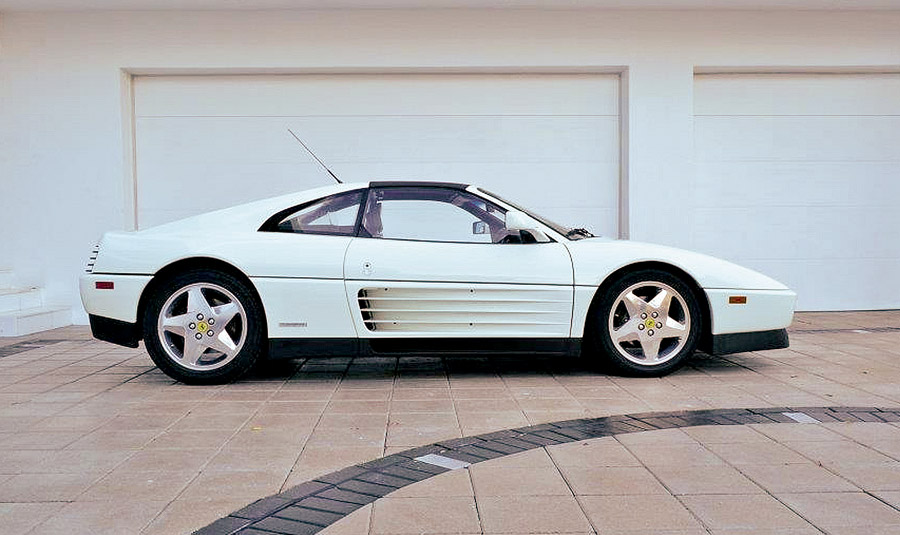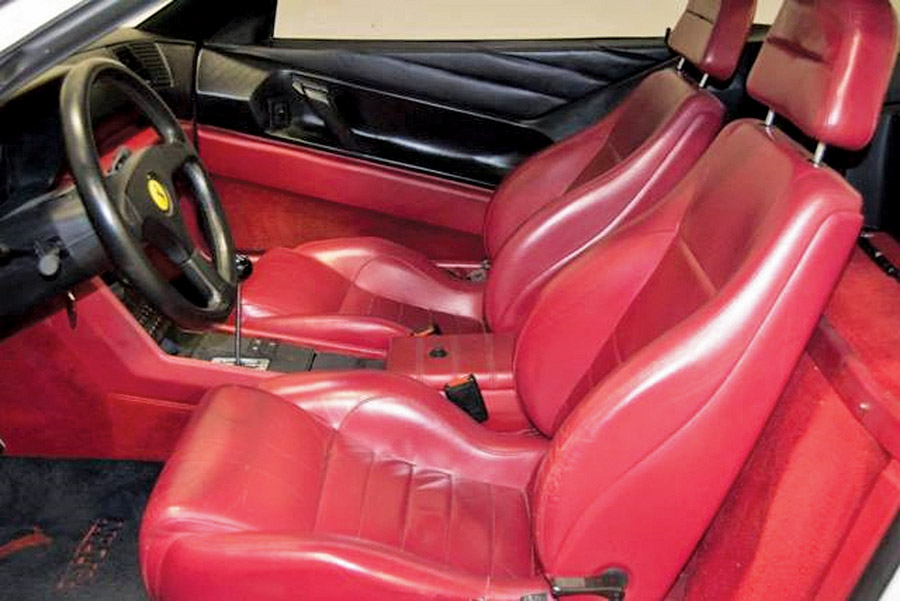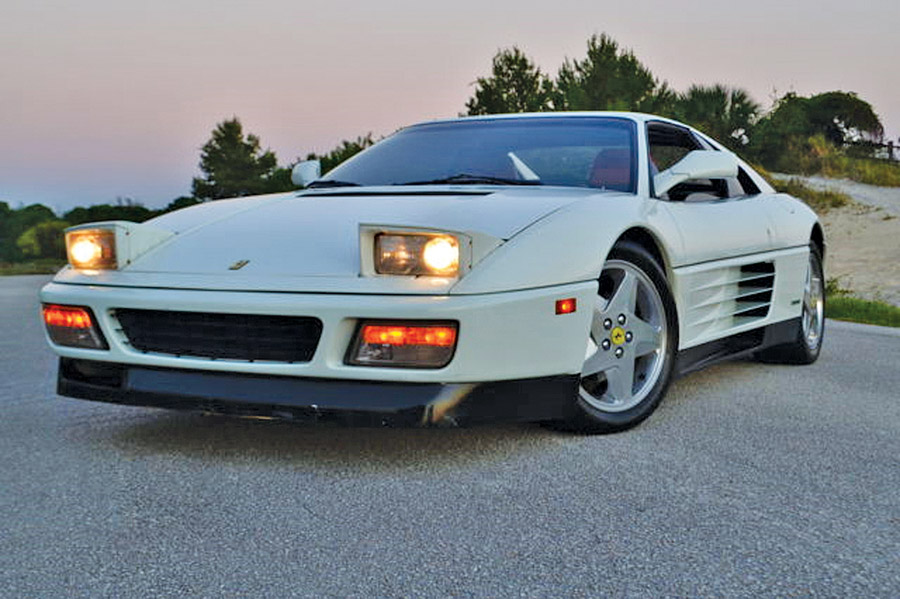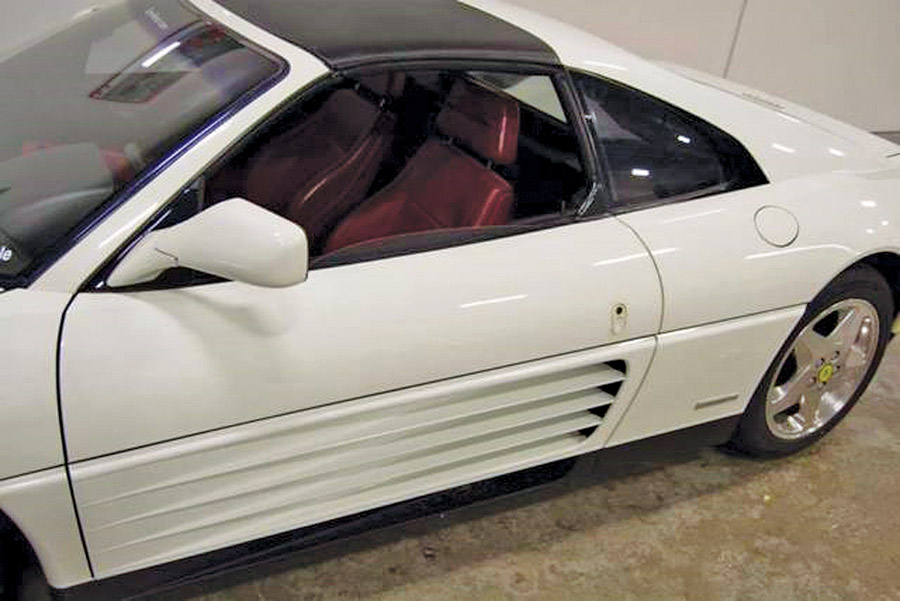SCM Analysis
Detailing
| Vehicle: | 1990 Ferrari 348 ts |
| Years Produced: | 1989–94 |
| Number Produced: | 4,228 |
| Original List Price: | $94,800 |
| SCM Valuation: | $58,300 |
| Tune Up Cost: | $8,500 |
| Chassis Number Location: | Stamped in right rear shock tower |
| Engine Number Location: | In the V of the engine near the oil filter. |
| Club Info: | Ferrari Club of America |
| Website: | http://www.FerrariClubofAmerica.org |
| Alternatives: | 1988 Lamborghini Jalpa, 1999 Lotus Turbo Esprit, 1989 Mercedes Benz 560 SL, 1990 Porsche Carrera 4 Targa, 1990 Rolls-Royce Corniche III |
| Investment Grade: | D |
This car, Lot 240, sold for $46,000, including buyer’s premium, at Auctions America’s Fort Lauderdale, FL, auction on March 21, 2017.
As the successor to Ferrari’s highly successful 308/328 series, the 348 had huge boots to fill. The 308 moved Ferrari from a brand that most Americans only knew from ABC’s “Wide World of Sports” coverage of the Monaco Grand Prix to one that was a major character in a hit TV show.
The 328 followed the 308. The 328 offered exceptional reliability, good performance and a price that a successful small-businessperson could afford.
The 348 had a great wave to ride, but factors beyond its control would doom it to also-ran status in Ferrari history books.
Montezemolo’s new vision
The 348 was a watershed event and a step into the future for Ferrari. The company was known for perfecting technology rather than innovating it, but that was about to change.
Luca Montezemolo took the reigns of the company after Enzo Ferrari’s death in 1988, and his vision was different from Enzo’s.
Montezemolo embraced technology and worked to position the company as a luxury brand and a showcase of forward thinking.
Montezemolo‘s vision started with a major remodeling of the factory. Trees were positioned around the factory floor to give the workers cleaner air and a more natural setting.
Natural lighting was increased to continue the theme. High-tech machinery was brought in to speed up and improve the assembly process. The grounds were manicured and the buildings facelifted.
The factory looked more like a Silicon Valley campus than an automobile plant.
Parallel to the factory upgrade, Montezemolo told Ferrari’s engineers to build cars of the future rather than the present. The 348 was their first attempt at the future.
Lighter and faster
By the late 1980s, the 328 was becoming dated. The 328’s steel body over a steel tube frame was heavy and expensive to build. The weight sapped the performance Ferrari needed to keep up with the competition. The 328’s longitudinal engine placement required the engine to be mounted on top of a transaxle. This made a high center of gravity, which compromised handling.
The 348 took aim at the 328’s shortcomings. The 348’s body was a lighter and less-expensive steel monocoque with an aluminum hood and engine cover. A steel subframe provided the cradle for the engine.
Power came from a new 3.4-liter V8. While the architecture of the 348 engine was similar to the 328’s, it was a completely new component. A modern Bosch Motronic engine-management system optimized the fuel and ignition delivery. Horsepower was upped from the 328’s 260 to 300.
The 348’s engine was placed longitudinally in the chassis with the transaxle placed behind — rather than under — the engine. The all-new transaxle was built as a transverse unit to take up less space. The “t” in the 348 ts stands for transverse transaxle.
Ferrari reported the 348 bettered the 328’s 6.6-second 0–60 mph time by over a second. Independent magazine tests proved that number was optimistic. Top speed was moved from 155 mph to the 170-mph range.
Magazine tests of early examples of the 348 reported the car felt light at high speed. The issue would be irrelevant to most owners, but the reports marred the car’s reputation to this day.
Pininfarina and shades of the Testarossa
The 348’s shape was the responsibility of Pininfarina. They chose the safe but reasonable path of building on Testarossa’s successful theme. The 348 featured the Testarossa’s trademark side strakes and rectangle taillights, with more-conventional rear fenders.
The look was attractive, but it reinforced the junior status of the 348 to the Testarossa.
Timing was the 348’s worst enemy. The Testarossa had had a great run, with production sold out years in advance. Small fortunes could be made reselling cars bought at list for market prices.
Speculation and a crash
The assumption was that the 348 would follow the trend. Clients and speculators flooded dealers with orders for the next cash cow. This time their luck didn’t hold out.
The collector car market in the late 1980s was on a run. The mantra of dealers and speculators alike became: “You can’t pay too much; you can only buy too soon.”
Anything with a Ferrari name on it was gold — until it wasn’t. As 1989 turned into 1990, the mood changed, and overnight, the party was over. Hot cars became hot potatoes, and the seller’s market became the seller’s nightmare.
The 348 was introduced just as the market collapsed. As deliveries trickled in, speculators on the 348 found there were no windfall profits to be reaped.
The news spread quickly, and the multi-year waiting lists vanished overnight. The market wasn’t the 348’s only problem.
In an effort to build the 348 more efficiently, less expensively, and lighter, Ferrari used more plastic and less metal. This resulted in hood and trunk lids that felt flimsy — and cheap-looking interiors.
Mechanical issues, such as inadequate alternators, didn’t help either. Sales were slow and it took what amounted to a $10,000 rebate program to clear out the final inventories.
Beautiful, reliable and still cheap
Time has been kind to the 348. The Testarossa-inspired styling still resonates with many people. The performance is still exciting and the mechanical components have proved reliable. The major service cost is exorbitant but still manageable.
The 348 was made in three body styles: The 348 tb was a coupe, the 348 ts was a Targa, and the 348 Spider was a full convertible. Auction America’s 348 ts was a Targa model with a lift-out roof panel.
Asking prices for the 348 exploded in 2015 as buyers migrated to modern Ferraris, but sales didn’t follow. When faced with a 348 and a 355 or 360 at nearly the same price, buyers went with the newer cars.
Today’s prices are still higher than in 2014, but they are back to a more realistic level in comparison with the competition.
A nice car — but not a premium car
Auctions America’s car was low mileage but not the best color. No mention was made of books, tools or service, so they are all probably needed.
A previous owner had wrapped the top in some kind of carbon fiber and chromed the wheels. It was probably in better condition than most 348s, but this was not a premium car.
The sale price was a little less than the car was worth. Ferrari buyers are skittish about the unknown, and there was little in the representation that instilled confidence in the car.
The buyer was a dealer who took the car back to Texas and quickly sold it for a profit. The seller left some money on the table, but it would take a retail atmosphere to make that money back. ♦
(Introductory description courtesy of Auctions America.)



